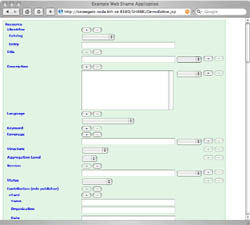ADLib: http://adlib.athabascau.ca/adlib/ (Login required; free registration)
The "ADLib repository provides a metadata entry tool to make the description of learning objects simple enough for the non-specialist. ADLib follows the CanCore Learning Resource Metadata Application Profile(CanCore), a set of guidelines for the uniform description of digital educational resources in Canada."
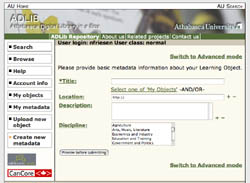
ALOHA 2: http://aloha2.netera.ca/
"ALOHA II is a Java-based software project that is being undertaken by Netera and the University of Calgary's Learning Commons in partnership with the Bolton Institute in the UK. The project represents part of a suite of tools in the eduSource project. The software has been designed for indexing, aggregating, sharing, multi-purposing, and re-purposing learning objects. It is created to meet the needs of indexers, educators and learners and includes versatile and powerful indexing tools and flexible searching of multiple educational object repositories. The software is based on the educational standards of IMS and SCORM. Currently it is designed to author Learning Object Metadata (LOM), build IMS Content Packages (IMS CP 1.22), build SCORM Sharable Content Objects (SCORM 1.2) and read IMS Vocabulary Definition Exchange (IMS VDEX) files."
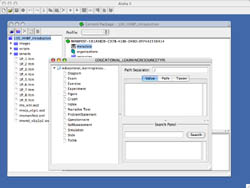
Automatic Metadata Generation Framework:
http://memling.cs.kuleuven.ac.be/amg/tryIt.php
The idea behind our framework is that learning object metadata can be derived from two different types of sources. The first source is the learning object itself; the second is the context in which the learning object is used. Metadata derived from the object itself is obtained by content analysis, such as keyword extraction, language classification and so on. The contexts typically are learning (content) management systems (like Blackboard) or author institution information. A learning object context provides us with extra information about the learning object that we can use to define the metadata.
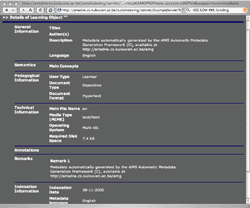
Curriculum Online Tagging Tool (v3x): http://www.curriculumonline.gov.uk/SupplierCentre/taggingtool.htm
"The Curriculum Online Tagging Tool is designed to make the process of creating metadata and outputting as easy and intuitive as possible for those suppliers who do not already have the means for doing so." A version of this tool is being developed to support UK LOM Core and aspects of CanCore.
"The tagging tool enables you to create and store details about your learning resources. It also allows you to add these details to the Curriculum Online portal so that teachers can find out about your learning resources. Once you've added details about a resource to the portal you can use the tagging tool to update them at any time, or even remove them completely."
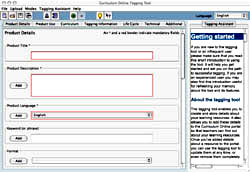
eduSource: eRIB Metatagging Tool: http://demo.licef.teluq.uquebec.ca/eRIB/
"This tool is concordant with the CanCore Guidelines and permits the user to create Metadata records for learning objects stored on a personal computer and thus constituting a personal repository (Repository-in-a-Box, RIB). The eRIB provides all the basic tools to add a new node to the eduSource network. It consists of an open source database (eXist) with a built-in LOM (IEEE Learning Object Metadata) data structure and a set of tools to create, manage and find metadata records in the eduSource Network. Some minimal requirements must be met before installing the eRIB. It exists in English and in French."
"To create your personal eRib, please download necessary software from http://edusource.licef.teluq.uquebec.ca/ese/en/install_erib.htm ."
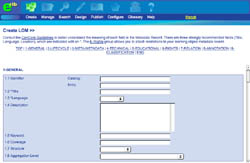
EXPLORA-II LCMS and Learning Object Repository / EXPLORA-II: http://explora2.licef.teluq.uquebec.ca/demo/
Explor@ (TM)-II is a software environment for the delivery of courses or distance learning events on the Internet. It allows creating a virtual training centre that delivers a set of courses on the Internet according to a variety of models and using a LO repository facilitating information access, production, follow-up and coaching of learners as well as training management. The LOR is fully compatible with the IEEE LOM, Cancore and Normetic. A demo version is available at http://explora2.licef.teluq.uquebec.ca/demo/ you may use the username and password DEMO to access the site.
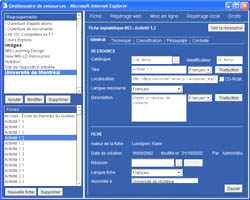
LOMPad: http://demo.licef.teluq.uquebec.ca/LomPad/
"Developed by theLICEF / COGIGRAPH Team, the LomPad is available for free as open source code for educational purposes. This tool allows the user to tag objects according to several major application profiles, namely LOM/IEEE, NORMETIC, CanCore and SCORM. The LomPad interface is bilingual, French and English.
To contribute to its evolution, the LICEF / COGIGRAPH Team invites you to communicate your observations and suggestions by using the LomPad Help Menu, choosing the option 'About us', and then click on the image to create an email addressed to us. "
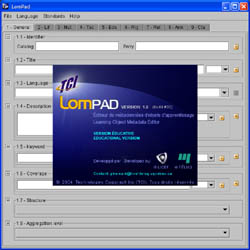
PALOMA: http://www.cogigraph.com:90/cogigraph/article.php3?id_article=58
PALOMA is a learning object and metadata manager with distributed repository access. It offers the following functionality:
- Management of unlimited folders in a tree-structured
- Editing Metadata for each learning object
- Managing rights associated to users, roles and groups according to folder and LOM record.
- Managing fully compliant IEEE-LOM including sub-set profiles such as SCORM, CanCore and Normétic ;
- Performing simple and advanced search based on metadata
- Multi-lingual interface (English, French, Spanish)
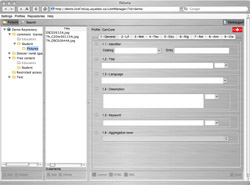
Reload v2.0: http://www.reload.ac.uk/index.html
"The tool supports all aspects of the latest and previous versions of IMS Content Packaging, including IMS Meta-data with IEEE LOM (Learning Object Metadata) vocabulary. It enables content to be aggregated into different structures and tagged with meta-data for exchange between systems and delivery to learners. A package viewer is to be incorporated to enable both authors and learners to interact with packages produced.includes the functionality to edit level A Learning Design manifests as well as Content Packages and Metadata records." Moreover, it includes the following tools:
- SCORM Player
- IMS Learning Design Editor (Levels A, B &C)
- IMS Learning Design Player
Note : The metadata editor is accessible in all these tools.

SHAME Web-editor Demo: http://kmr.nada.kth.se/shame / http://knowgate.nada.kth.se:8180/Speed/main
"SHAME is currently a framework for building editors, presentations and query interfaces for resource centric RDF metadata. In practise it is a library that easily can be integrated into various applications. Since specific applications / deployments need to edit different sets of metadata the SHAME framework provides a configuration procedure from where applications is generated. The core and main benefit of SHAME is it's configurability through a data modeling part (SHAME Query Model) and a form-specification part (SHAME Form Model)."
